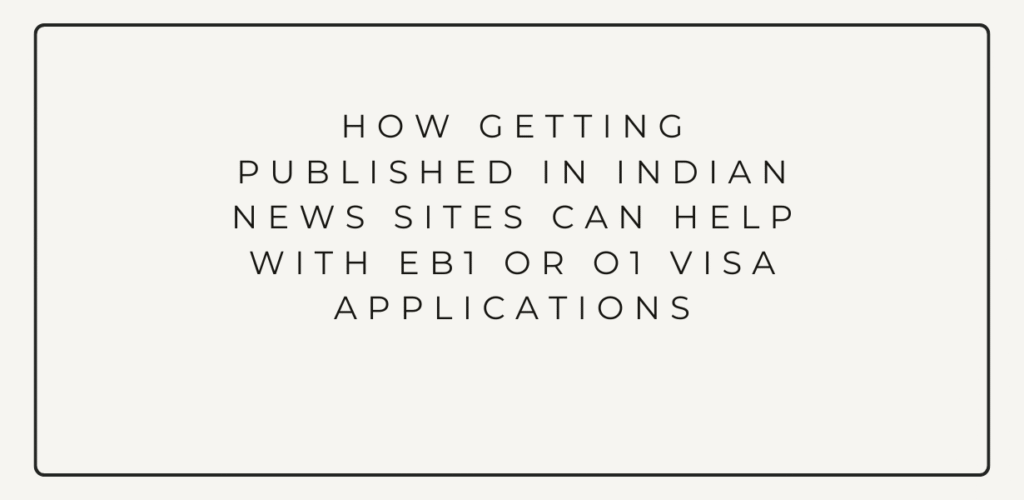
published in Indian news sites is a strategic and powerful way to strengthen your EB1 visa or O1 visa application. By showcasing your achievements in reputable outlets, you can demonstrate international acclaim, build credibility, and connect with the Indian diaspora, all of which align with USCIS criteria. A game-changer for your U.S.immigration journey.For more information (read this). If you need help with PR and Media Publishing contact through linkedin or info@qimedia.in
1. How can Indian news publications strengthen my EB1 or O1 visa application?
Answer:
Indian news publications, such as The Times of India, The Hindu, or India Today, are considered major media by the U.S. Citizenship and Immigration Services (USCIS), satisfying the criterion of “published material about the applicant in professional or major media.” Being featured in these outlets demonstrates international acclaim and extraordinary ability, key requirements for EB1 visa help and O1 visa applications. Coverage in Indian media highlights your achievements to a global audience of over 1.4 billion, including the 2.9 million Indian diaspora in the U.S., enhancing your credibility and visibility. For example, an article in NDTV about your tech innovation or artistic contribution can provide third-party validation, making your immigration profile more compelling.
2. Why are Indian news sites particularly effective for EB1 and O1 visa applications?
Answer:
India’s media landscape is vast and influential, with 70% of Indians accessing online news and 54% using platforms like YouTube for updates. Reputable outlets like The Indian Express or CNBC-TV18 have high readership and global reach, making them “major media” under USCIS guidelines. Additionally, Indian news publications resonate with the Indian-American diaspora, a key demographic in the U.S., fostering networking opportunities and endorsements. Coverage in these outlets also generates high-authority backlinks, boosting your digital presence and SEO, which USCIS officers may review to verify your prominence. This combination of credibility, reach, and cultural relevance makes Indian news publications a powerful tool for EB1 visa and O1 visa applications.
3. What types of Indian news publications should I target for my visa application?
Answer:
Focus on reputable, high-circulation outlets to meet USCIS standards for “major media.” Top choices include:
- Print and Digital Newspapers: The Times of India, The Hindu, The Indian Express, and India Today.
- Television and Online Media: NDTV, Times Now, and CNBC-TV18 for interviews or features.
- Digital-First Platforms: YourStory (for startups), The Better India (for social impact), or IndianEagle’s Travel Beats (for diaspora stories).
- Business and Tech Portals: Economic Times or Business Standard for professionals in business or tech. Choose outlets with strong readership and credibility, and ensure the coverage focuses on your achievements to align with EB1 visa help or O1 visa requirements.
4. What kind of story should I pitch to Indian news sites to support my visa application?
Answer:
Your pitch should highlight your extraordinary ability or significant contributions in your field, tailored to resonate with Indian audiences. Examples include:
- Innovations or Achievements: A tech entrepreneur could pitch a story about their U.S.-based startup impacting India’s economy.
- Cultural Contributions: An artist of Indian descent could share their work blending Indian and Western art forms.
- Social Impact: A researcher could highlight their work on climate change or healthcare featured at a global conference. Include specific achievements (e.g., awards, patents, or speaking engagements) and emphasize your connection to India, such as heritage, collaborations, or diaspora engagement. A compelling, authentic story increases your chances of being featured in Indian news publications.
5. How do I get published in Indian news sites while living in the U.S.?
Answer:
To secure coverage in Indian news publications, follow these steps:
- Develop a Strong Press Release: Craft a professional press release with a catchy headline, key achievements, and quotes from yourself or industry experts. Highlight relevance to Indian readers.
- Research Media Outlets: Identify journalists or editors at target publications (e.g., The Hindu or YourStory) via their websites or X profiles.
- Leverage Networks: Connect with Indian-American organizations or diaspora groups like IndianEagle for introductions to media contacts.
- Use Social Media: Engage with Indian journalists on X or LinkedIn, sharing snippets of your work to build relationships.
- Hire PR Support: Consider a PR agency specializing in Indian media to pitch your story effectively.
- Be Persistent: Follow up politely with editors and offer exclusive angles to stand out. Consistency and a culturally relevant narrative are key to securing coverage.
6. Can social media amplify the impact of my Indian media coverage for visa applications?
Answer:
Yes, amplifying your Indian news publication coverage on social media platforms like X, LinkedIn, Instagram, or WhatsApp can enhance its impact. India has a highly active online audience, with 88% using platforms like Instagram and 48% using WhatsApp for news. Sharing your feature on these platforms:
- Increases visibility among the Indian diaspora and professional networks.
- Drives traffic to the article, boosting its SEO and credibility.
- Encourages endorsements or recommendation letters from peers, which are valuable for EB1 visa and O1 visa applications. For example, posting a link to your India Today feature on X with relevant hashtags (e.g., #EB1Visa, #IndianDiaspora) can attract attention from influencers and communities, further validating your acclaim.
7. Are there any risks associated with using Indian media for EB1 or O1 visa applications?
Answer:
While Indian news publications are powerful, there are potential risks:
- Bias or Misrepresentation: Some outlets may have political leanings or sensationalize stories, which could misalign with your narrative. Verify the publication’s credibility before pitching.
- Paid Features: Advertorials or sponsored content may not carry the same weight with USCIS unless clearly distinguished as editorial content.
- Overemphasis on Media: Relying solely on media coverage without other evidence (e.g., awards or recommendation letters) may weaken your case. To mitigate these, choose reputable outlets, review articles for accuracy, and consult an immigration attorney to ensure your Indian news publication coverage meets USCIS standards.
8. How does Indian media coverage compare to U.S. media for EB1 and O1 visa applications?
Answer:
Both Indian and U.S. media can satisfy the USCIS “major media” criterion, but Indian news publications offer unique advantages:
- Accessibility: Indian outlets may be easier to pitch to due to less competition compared to U.S. outlets like The New York Times.
- Cultural Relevance: Indian media resonates with the 2.9 million Indian-American diaspora, strengthening your ties to a key U.S. demographic.
- Global Reach: India’s media reaches a massive international audience, supporting claims of international acclaim. However, U.S. media may carry more weight for domestic recognition. Ideally, combine both for a robust application, using Indian coverage to highlight global impact and U.S. coverage for local prominence.
9. What other evidence should I include alongside Indian media coverage for my visa application?
Answer:
To build a strong EB1 visa or O1 visa application, pair Indian news publication coverage with:
- Awards or Prizes: National or international recognitions in your field.
- Recommendation Letters: Endorsements from industry leaders or peers.
- Memberships: Associations requiring outstanding achievements (e.g., IEEE for engineers).
- Contributions: Evidence of original work, such as patents, publications, or projects.
- High Remuneration: Proof of a high salary compared to peers. For example, an NDTV feature about your AI research, combined with a patent and a recommendation letter from a professor, creates a comprehensive case for extraordinary ability.
10. How do I ensure my Indian media coverage is accepted by USCIS?
Answer:
To ensure your Indian news publication coverage meets USCIS standards:
- Choose Reputable Outlets: Select well-known publications like The Times of India or The Indian Express with verifiable circulation data.
- Focus on Editorial Content: Avoid advertorials unless clearly labeled as editorial to maintain credibility.
- Document Properly: Include full articles, publication dates, and URLs in your application. Screenshots or PDFs are helpful.
- Highlight Achievements: Ensure the coverage focuses on your professional accomplishments, not personal anecdotes.
- Consult an Attorney: Work with an immigration lawyer to present your media coverage effectively and align it with other evidence. Proper documentation and reputable sources ensure your coverage is viewed as credible by USCIS.
11. Can diaspora-focused Indian media outlets help with EB1 or O1 visa applications?
Answer:
Yes, diaspora-focused outlets like IndianEagle’s Travel Beats or American Bazaar are valuable for EB1 visa help and O1 visa applications. These platforms target the Indian-American community, which aligns with USCIS’s interest in your influence within significant demographics. Coverage in such outlets can:
- Demonstrate your impact on the 2.9 million Indian diaspora in the U.S.
- Facilitate networking with influential community leaders for recommendation letters.
- Provide culturally relevant content that strengthens your narrative of global acclaim. While these may not carry the same weight as The Hindu, they complement mainstream Indian media by showcasing diaspora engagement.
12. How long does it take to secure media coverage in Indian news sites?
Answer:
The timeline for securing coverage in Indian news publications varies:
- Pitching and Outreach: Crafting a press release and contacting journalists may take 1–4 weeks, depending on your network and story strength.
- Publication Process: If accepted, articles or interviews can be published within days to a few weeks, depending on the outlet’s schedule.
- PR Agency Support: Hiring a PR professional can expedite the process to 2–6 weeks but may involve additional costs. Start early, ideally 3–6 months before your visa application deadline, to allow time for multiple features and to amplify them on social media for maximum impact.
13. Can I use paid media or advertorials for my EB1 or O1 visa application?
Answer:
Paid media or advertorials can be risky for EB1 visa and O1 visa applications. USCIS prioritizes editorial content from reputable sources, as paid features may be seen as lacking objectivity. If you pursue paid content:
- Ensure it is clearly labeled as editorial or written by a journalist to maintain credibility.
- Choose high-authority outlets like Business Standard to avoid scrutiny.
- Supplement with unpaid coverage, awards, or recommendation letters to strengthen your case. Consult an immigration attorney to ensure paid content aligns with USCIS guidelines and doesn’t undermine your extraordinary ability claim.
14. How can I maintain visibility after being featured in Indian news sites?
Answer:
To sustain the impact of your Indian news publication coverage:
- Share on Social Media: Post links to your feature on X, LinkedIn, and Instagram, using hashtags like #EB1Visa or #IndianDiaspora to reach wider audiences.
- Engage with Diaspora: Attend Indian-American events or webinars to network and gain further endorsements.
- Contribute Guest Articles: Write for Indian outlets like YourStory to maintain media presence.
- Update Your Portfolio: Add media coverage to your website and visa application materials. Regular engagement keeps your profile relevant and supports your claim of sustained acclaim for EB1 visa help or O1 visa approval.
15. Do I need an immigration attorney to leverage Indian media for my visa application?
Answer:
While not mandatory, an immigration attorney is highly recommended to maximize the impact of your Indian news publication coverage. An attorney can:
- Ensure your media coverage meets USCIS criteria for “major media.”
- Help you present articles alongside other evidence, like awards or recommendation letters.
- Advise on avoiding pitfalls, such as using paid content or less reputable outlets.
- Tailor your application to highlight extraordinary ability or international acclaim. Attorneys provide expertise to align your media strategy with USCIS expectations, increasing your chances of EB1 visa or O1 visa approval.

